112015_YKPT_B9.pdf





November 20, 2015 www.plaintalk.net
Heritage 2015
City Government Led By Its Citizens
MAYORS OF
VERMILLION
Other ordinances prohibited prostitution, dealt with animal control, fire
safety and assessing fees and taxes to
support the city government.
The current form of city government was adopted in 1966.
The City of Vermillion operates
under the Council-Manager form of
municipal government.
This form combines the strong
political leadership of elected officials
with the strong managerial experience
of an appointed manager. All power
and authority to set policy rests with
an elected governing body, which
includes a mayor and members of the
City Council. The governing body in
turn hires a nonpartisan manager who
has very broad authority to run the
organization.
According to the City’s website,
“The Council-Manager form promotes
effective management within a transparent, responsive, and accountable
structure. Since its establishment, the
Council-Manager form has become the
most popular structure of local government in the United States. The form
is also widely used throughout the
world. The Mayor and City Council
represent the community and develop
the long-range vision for the future
of Vermillion. They establish policies
1877-1878: John L. Jolley
1878-1885: Dr. Frank N.
Burdick
1885-1886: John L. Jolley
1886-1887: Dr. Frank N.
Burdick
1887-1889: Silas W. Kidder
1889-1889: Silas N. Palmer
1889-1890: Jesse Burchard
1890-1892: Dr. Frank N.
Burdick
1892-1896: Andrew E. Lee
1896-1898: L.T. Swezey
1898-1898: Dr. Frederick W.
Cox
1898-1899: J.A. Carson
1899-1900: Dr. Frederick W.
Cox
1900-1903: Halvor E. Hansen
1903-1904: W.C. Bryant
1904-1911: Henry L. Ferry
1911-1913: George Kempker
1913-1916: Charles E. Prentis
1916-1918: Richard F. Lyons
1918-1921: William H. Beede
1921-1923: Martin L. Thompson
1923-1932: Dr. Carl Viers
1932-1934: P.F. Cavanaugh
1934-1942: Dan E. Sullivan
1942-1947: R.D. Thompson
1947-1948: H.W. Frankenfeld
1948-1949: Henry A. Benson
1949-1951: W.H. Jarmuth
1951-1952: Hugh F. Lee
1952-1954: Ralph H. Leer
1954-1956: W.H. Jarmuth
1956-1960: Robert F. Patterson
1960-1962: Ralph H. Leer
9B
BY SHAUNA MARLETTE
shauna.marlette@plaintalk.net
The founders of Vermillion’s city
form of government faced many of the
same responsibilities being met by the
governing body today.
Key to them all was making sure
that Vermillion was a safe and enjoyable community.
In 1873, the City had developed to
the point that the community felt it
was time to create official ordinances
to govern the health and safety of the
community.
They chose to create a “Board of
Trustees” who then drafted the original 11 ordinances.
In an attempt to make Vermillion
safer they:
• Made gambling illegal both in
public and in private homes
• Declared it unlawful for any person to sell or dispose of “indecent or
lewd book, picture or other thing.”
• Racing of horses or mules was
outlawed in city limits.
• The shooting of guns or fire crackers.
• The carrying of concealed weapons.
• Loitering for five days without any
legal occupation or means of support.
Court
From Page 7B
county clerk was “…about
as cheap as could have been
built,…”. On September 6,
1881, citizens of Vermillion
offered to provide land and
money toward the construction of a county courthouse.
Four different proposals
were presented for different locations and differing
amounts of money which
would be provided by the
city residents.
On September 8th the
Clay County Commissioners decided that if the city
would provide lots 8, 9 and
10 and part of lot 11 of Block
27 of the Original Town
site of Vermillion and $800
toward the construction of a
county office building, that
the county would contribute
$2,000 towards the construction costs. These lots were
located at the northeast
corner of the intersection
of Court Street and Kidder
Street (where the post office
is now located).
On October 6, 1881,
the county commissioners awarded a contract to
George A. Porter for the construction of the courthouse
at a cost of $2,800. The new
county courthouse, on Court
Street (hence the name), was
erected during the winter of
1881-1882.
On May 20, 1882, the
county commissioners
inspected the new building
and accepted it as they were
satisfied that it was completed in accordance with
the contract. The new wood
frame courthouse structure
on Court Street was constructed at a cost of $4,000,
including $2,000 which was
appropriated by the county
commissioners, and the
balance was raised by public
subscription.
Certainly due in part to
the rapidity of its construction, within thirty years, the
1882 courthouse was showing its age. By the turn of
the century, the courthouse
was in terrible condition. As
indicated in the June 9, 1910
edition of the Dakota Republican, Clay County had “…
scrimped along for a decade
of years with an old rattle
trap, wooden shell building
for a courthouse… ‘.
In September of 1906 a
group of citizens presented
the county commissioners
with a petition asking that
a new courthouse be built
because the county records
were unsafe in the existing
building. An election on
the proposal was held on
November 6, 1906 and it was
defeated by a vote of 796
in flavor of the courthouse
to 975 against. Some of the
opponents objected to the
proposal to pay for the
new courthouse through a
special tax levy while others
in the northern part of the
county opposed the construction of another courthouse in Vermillion because
they wanted the county seat
moved to a more central
location in the county.
On April 6, 1910, another
petition, this signed by 330
voters, was presented to
the county commissioners
asking that a 3 mil tax levy
be imposed for four years
to create a sinking fund for
the construction of a new
courthouse. The petition
pointed out that the existing
courthouse was inadequate
for the needs of the county
both in capacity and in security for the county records in
case of fire. The petitioners
also represented that the
existing courthouse would
soon require costly repairs
and additions to meet the
growing demands.
In response, the county
commissioners set an
election for June 7, 1910,
on the issue of whether to
construct a new courthouse.
At the election on June 7,
1910, the proposal for a new
courthouse passed by a vote
of 851 in favor of building
a new courthouse to 657
votes against
On September 6, 1910,
the county commissioners
made the decision to assess
$15,300 in taxes for the year
1910 for the courthouse
building fund.
In October the county
commissioners began
considering possible sites
for the new courthouse and
initially considered two
possible sites: the Chandler
House Hotel site with four
lots and the buildings, (the
present location of the Old
National Guard Armory)
which was available for
$6,000 and the Catholic Convent grounds (the Southwest
corner of the intersection of
Kidder and Austin Streets)
which was available for
$9,500, but no decision was
made at that time.
On January 26, 1911,
the commissioners again
considered possible locations for the new courthouse
and decided to advertise for
sites with anyone who was
interested in selling their
property to submit proposals by February 6, 1911.
By the meeting on February 6, 1911, the commissioners had received 16 different
proposals for locating the
courthouse.
Former Mayor and
Congressman John L. Jolley
proposed to sell his property
in Block 37 to the county for
whatever three “fair men”
valued it at. Congressman
Jolley also submitted a proposal whereby the county
would acquire the lots but
the Congressman and his
wife would retain possession
of their home, in Block 37
during their lifetimes.
On March 8, 1911, the
county commissioners
decided to build on Block
37 of Snyder’s addition to
the City of Vermillion. Block
37 was owned by John L.
Jolley (Northeast quarter)
A.H. Whittemore (Northwest
quarter), Mrs. O’Connor
(Southwest quarter) and
Mrs. Schafer (Southeast
quarter) and that the total
purchase price would be approximately $12,500.
On June 9, 1911, Architect
Lloyd D. Willis of Omaha
appeared at the commissioner’s meeting and showed
them sketches and plans
for the courthouse and , according to the minutes of the
meeting, the commissioners
spent the “forenoon” considering his plans. The next day,
June 10, 1911, various other
architects appeared and offered to furnish plans for the
courthouse. Willis, the low
bidder, was selected.
On June 21, 1911, a formal
resolution was passed to
build a new courthouse. The
votes were 2 in favor and 1
against. Voting in favor of
building a new courthouse
were commissioners T.O.
Ellison and Iver A. Iverson
and voting against building a courthouse was G. W.
Richardson, the chairman of
the commissioners.
On October 3, 1911, the
commissioners opened the
bids for construction of the
new courthouse. According
to The Dakota Republican,
the architect told their
reporter that the bids came
in below his expectations.
Fourteen bidders submitted
bids on the construction
contract.
that affect the overall operation of
the community and are responsive to
residents’ needs and wishes.”
The governing body is made up
of nine members. Eight City Council
members are elected from four wards,
with two members representing each
ward. The Mayor is elected at-large
and presides over City Council meetings. The mayor may vote on all
matters coming before the governing
body.
With the consent of the City Council, the Mayor appoints individuals to
serve on the Library Board and Planning Commission.
The Library Board oversees the
operations of the Vermillion Public Library and appoints a Library Director.
All services and programs provided by
the library are overseen by the board.
The Planning Commission is
charged with overseeing the longrange planning of the community,
including zoning issues, subdivisions
and formulation of the Comprehensive Plan. The Planning Commission
serves a vital role in recommending
major policy changes to the governing body for the development of the
community.
COURTESY PHOTOS: ARTHUR RUSCH
The second of three courthouses in Clay County
history was located at the northeast corner of
the intersection of Kidder Street and Court Street
(where the Post Office is located now.) Pictured
in front are members of the first class of the
University of South Dakota.
On October 4, the county
commissioners decided to
accept the low bid of Hintz
& Malloy. The county also
agreed to hire P.E. Henzie as
the construction superintendent for $5 per day.
There was a festive laying
of the cornerstone for the
new courthouse on June 8,
1912, which was conducted
by the Vermillion Masonic
Lodge. The celebration
included a parade to the
courthouse site, and speeches by various dignitaries.
According to The Dakota
Republican, over 2000 people
attended the cornerstone
laying and that it was “…one
of the most notable events of
Masonic history in Vermillion.”
During the construction,
on November 4, 1912, an
accident occurred in which
some support props slipped
and concrete which had
been poured but which had
not yet dried sufficiently,
dropped to the third floor.
The Vermillion Plain Talk
estimated that some twenty
tons of concrete and tile
fell, carrying three workmen
with it. The paper reported
that only one of the workmen was bruised but that
the workmen were all pretty
badly scared but thankful to
escape with their lives. The
paper also commented that
the strength of the courthouse was shown by the fact
that the fall of twenty tons
of concrete and brick wasn’t
enough to even jar the rest
of the building.
On February 24, 1913,
Civil War veterans who
were members of the GAR
(Grand Army of the Republic) Miner Post #8 presented
the commissioners with
a sixteen foot silk flag for
use at the new courthouse
and on the same date the
commissioners interviewed
17 applicants for janitor and
selected John Bergman who
had offered to work for $40
per month.
With the new courthouse
nearing completion, on April
1, 1913 the county commissioners accepted a petition
to sell the old courthouse
and jail on Court Street and
on April 17, 1913, they inspected the new courthouse
with the architect and found
it complete and in accordance with the plans and
specifications.
On April 22, 1913, the
county commissioners
resolved that the county
officers should move into
the new building and
that after that date, the
new courthouse building
would officially be the Clay
County Courthouse. The
first meeting of the county
commissioners in the new
courthouse was held on May
6, 1913.
A dedication ceremony
for the new courthouse
was held on Thursday June
19th, 1913. The dedication
was conducted by the Odd
Fellows Lodges of Vermillion and Wakonda. The main
speaker at the dedication
was Odd Fellows Grand Master S.E. Wilson and speeches
were also given by pioneer
settlers of Clay County, John
Norin, Ellis White, John
Bruyer, John Jolley and M.D.
Thompson.
The Clay County Courthouse is a rectangular, threestory, “Bedford” yellowstone building, with a central
skylight, which has now
been covered to save energy.
The building is constructed
in a Neo-Classical style.
The front and sides are
symmetrical with three bays
on each façade, of which the
center bay projects slightly
forward. There is a highly
decorated pediment on the
central bay of the front and
on each side. The building
consists of two stories above
a raised basement. The basement area creates the appearance of a podium upon
which the upper stories rest.
The basement level is of rusticated “Kettle River” stone
which flares outward while
the upper two floors are of
vertically ribbed dressed
stone.
Between the first and
second floors is a projecting
belt course of stone. The
center bay on the front facade, which projects forward
creating the appearance of
a portico, has a recessed
front entrance on the ground
level. On the second and
third floor is a large window
flanked on each side by Ionic
columns running the length
of the second and third
floors. The windows on the
side bays are plain with no
adornment.
The stairs to the front
entrance rise between projecting low, stone walls with
lamp standards on either
side. The building is topped
with a heavy overhanging
John L. Jolley, first
mayor of Vermillion
1962-1974: John T. Barstow
1974-1976: Charles L. Amant
1976-1980: Lester J. Parry
1980-1982: Charles Woodman
1982-1988: Merle L. Offerdahl
1988-1992: Betty J. Lynn
1992-1994: Grant A. Sammelson
1994-2001: William J. Radigan
2001-2004: Roger L. Kozak
2004-2010: Daniel D. Christopherson
2010-present: John E. Powell
CITY MANAGERS
1966-1970: Michael G. Miller
1970-1973: Charles Kent McClain
1974-1983: Carl D. Weinaug
1983-1989: James W. Antonen
1989-2002: Jeff Pederson
2002-2004: James Patrick
2005-Present: John C. Prescott
cornice with dentil moldings
and a parapet. The building is raised above street
level by a sandstone wall on
the front and sides at the
sidewalks.
The courthouse was
designed by Lloyd Willis,
an architect from Omaha. It
was built by Hintz & Malloy,
contractors from Aberdeen,
the plumbing and heating
was done by P.F. Cavanaugh,
a local contractor from
Vermillion and the electrical
work was done by Brookman
& Barrett, also of Vermillion.
The wood furniture in the
Courthouse was provided
by Brown & Sanger of Sioux
Falls, the jail equipment was
furnished by Stewart Iron
Works of Cincinnati, the electric light fixtures came from
the Chicago Gas & Electric
Fixture Manufacturing Co of
Chicago and the metal vault
equipment was furnished by
the Steel Fixture Manufacturing Co. of Topeka, Kansas.
The Clay County Courthouse was placed on the
National Register of Historic
Places in 1983 (#83003005).
Major improvements
which have been made to
the courthouse since its
construction include the
installation of the elevator
in 1966, the rear vestibule in
1982, and the attached Public Safety Center in 1989.


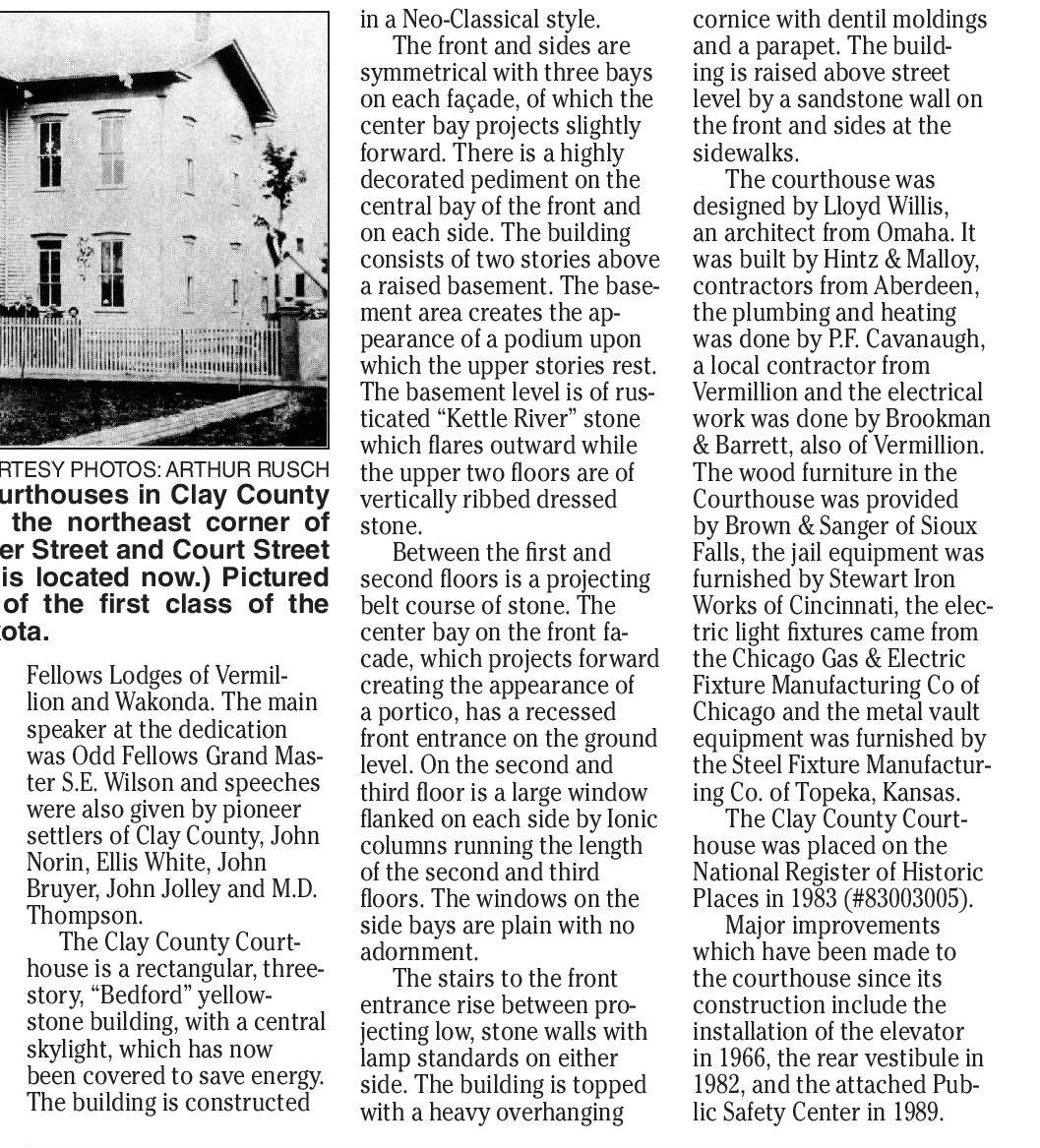
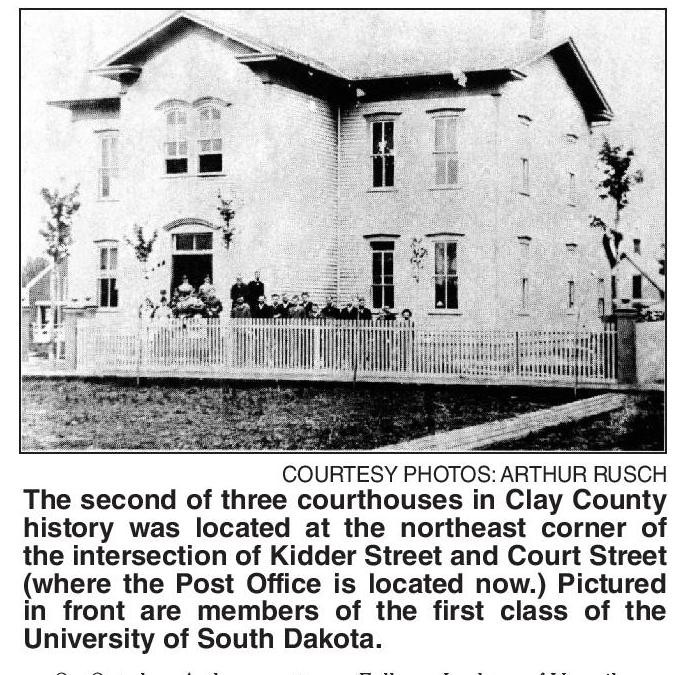



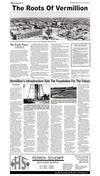

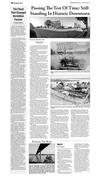
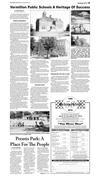



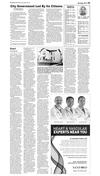



 Previous Page
Previous Page






